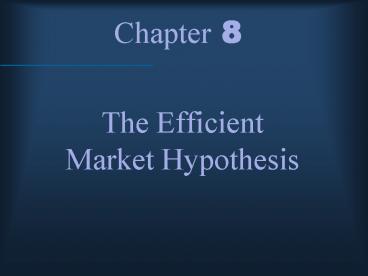The Efficient Market Hypothesis - PowerPoint PPT Presentation
1 / 25
Title:
The Efficient Market Hypothesis
Description:
... in previous 3-5 yrs likely to give you above average returns over next 3 years. Evidence of castles in the air fading or forming versus efficient markets ... – PowerPoint PPT presentation
Number of Views:84
Avg rating:3.0/5.0
Title: The Efficient Market Hypothesis
1
Chapter 8
- The Efficient Market Hypothesis
2
Random Walk and the EMH
- Stock prices should reflect all current
information. - Expectations of future performance should effect
current performance/prices - Stock price changes thus respond to new
information, which is unpredictable
3
- Changes in stock prices are random/unpredictable
thus follow a random walk. - Evidence of efficiency prices determined
rationally. - EMH prices of securities fully reflect
available information about securities.
4
EMH and Competition
- Stock prices fully and accurately reflect
publicly available information - Once information becomes available, market
participants analyze it - Competition assures prices reflect information
5
EMH and All Available Information
- Weak Form Stock prices reflect all information
that can be derived from past trading data, e.g.
price, volume. Trend analysis/charting is futile.
- Semi Strong Form All publicly available
information (management style, balance sheet,
forecasts) are reflected in prices.
6
- Strong Form All public/private information is
included in the stock price. Insider information
is irrelevant as insiders bid up prices to
competitive levels.
7
Technical Analysis
- Search for recurring and predictable patterns in
stock prices. - Stock prices change slowly, such that adjustment
can be exploited - Example Relative Strength, compare stock
performance relative to market (SP500). An
increasing ratio indicates profitable
opportunities to buy. - EMH says this is worthless.
8
Fundamental Analysis
- Using economic and accounting information to
determine the present value of the payments
stockholders will receive. - Values above the current price indicate buying
opportunities. - Competition by well financed firms will result in
prices that account for most information. - Must identify companies that are undervalued or
overvalued by others to profit.
9
Implications of Efficiency for Active or Passive
Management
- Active Management
- Security analysis
- Timing
- Passive Management
- Buy and Hold
- Index Funds
10
Market Efficiency and Portfolio Management
- Even if the market is efficient a role exists for
portfolio management - Diversification
- Tax considerations
- Other considerations
11
Issues of Efficiency Debate
- Magnitude How does one measure the contribution
of the manager. - Selection bias Schemes that fail get publicity,
those that succeed are kept quiet. - Lucky event Chance says someone must win
12
EMH Tests
- Weak form tests Predictability in stock
returns. - Semi strong form tests Market anomalies.
- Strong form tests Insider Information
13
Momentum in stock prices
- Indicated by positive serial correlation over
short holding periods. - LoMacKinlay (1988) find weakly and monthly
holding periods show a small amount of serial
correlation in a broad portfolio - May relate to lag in which positive info
influences large, then small stocks.
14
Reversals?
- Longer holding periods show () serial
correlation. - Indication of fad/overshooting.
- Varying risk premiums
- Small number of observations.
15
Losers become winners and vice versa
- Thaler and DeBondt (1985) Poorly performing
stocks in previous 3-5 yrs likely to give you
above average returns over next 3 years. - Evidence of castles in the air fading or forming
versus efficient markets reacting to interest
rate movements.
16
Interest Rates and Reversals
- As interest rates rise, bond prices fall as do
stock prices. - Bonds/stocks offer low to negative returns over
the period in which rates rose. - Rates fall revert to mean, and stock prices rise,
ie above average returns.
17
January and Friday Effects
- Abnormal effect of higher stock returns during
the first few days of January. Particularly
evident in small firms. - Tax effects drive prices down in Dec.
- Small firms more volatile, ie losses.
- Lack of institutional investors, transactions
costs allows this effect to continue. - Blue Monday buy on Mon., sell Fri.
18
Fundamentals and Stock Price Anomalies
- Look for securities that
- Are relatively small
- Sell at low multiples compared to earnings.
- Have low prices relative to asset value
- Have high dividend yields.
19
Smaller is better
- Since 1926 small company stocks have produced a
rate of return 2 higher than large stocks. - Results of Fama and French confirm similar
finding when controlling for beta. - Beta poor measure of risk for small firms.
- Survivorship bias
- Results did not hold during late 90s.
20
P/E ratios
- During 1980s, as P/E ratio increased return
decreased. - Relationship varies over time.
- P/E ratio low for a reason, ie financial
collapse.
21
Price to book value
- Book value the value of a companys assets as
recorded on its books. - Stocks with low price to book value tend to have
higher future returns. - Consistent with Warren Buffetts investment
strategy. - These stocks may be fundamentally riskier.
22
Dividend Yields
- Strategy of buying stocks with highest dividend
yield does not consistently beat market. Dogs
of the Dow - Related to interest rate movements and mean
reversion.
23
Implications of Test Results
- Risk Premiums or market inefficiencies
- Anomalies or data mining
- Behavioral Interpretation
- Inefficiencies exist
- Caused by human behavior
24
Behavioral Possibilities
- Forecasting Errors
- Overconfidence
- Regret avoidance
- Framing and mental accounting errors
25
Mutual Fund and Professional Manager Performance
- Some evidence of persistent positive and negative
performance - Near term.
- Survivorship bias, ie loser funds do not exist
over a long period of time. Incubator funds. - 2/3 of existing funds outperformed by SP 500.
- As size of fund increases the number of stocks
available to trade decreases.































